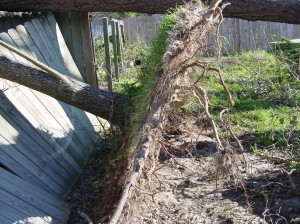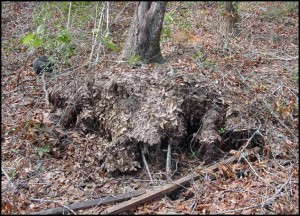After severe weather of any kind, homeowners must often spend a considerable amount of time dealing with impacts to their landscapes. Below are a few lessons we have learned from hurricanes and tropical storms in the past. Many thanks to fellow agent Beth Bolles for her contributions to this article.
Dealing with Toppled Trees
It may be difficult to turn an uprooted favorite tree into firewood, but this is probably the best choice. A small or young tree may be replanted successfully if done immediately. These trees will require bracing for up to two years until the root systems regrow and are able to support themselves. If the roots have been exposed for an extended period of time, don’t try and save the tree. Exposed roots should be covered with soil or moist burlap for protection from drying out. Large or older trees will typically not survive this ordeal even with the best of care. Because the root system is compromised, attempting to keep the tree may create a hazard down the road with the next storm.

If a tree is completely uprooted, its odds of recovery are severely limited and it is best to remove the tree. Photo courtesy Beth Bolles, UF IFAS Extension
When removing fallen trees, think ahead about whether you plan to remove stumps. It’s a lot easier to pull instead of dig stumps out of the ground, so leave a four-foot stump to make your life easier. Be careful using power equipment like chain saws. It may be better to hire a professional to deal with removing large trees, especially around power lines.
Exposed Roots or Leaning Trees
Any exposed roots should be covered immediately. Cover roots with nearby soil at the same level roots were originally growing. Do not bank the soil higher because this will cut off oxygen supplies to roots in an already oxygen deprived, saturated soil.
If small trees are leaning and need straightening, they can be staked and treated like a newly planted tree. Larger trees with trunks greater than six inches in diameter can be saved but should be removed if they are a hazard to structures, power lines, or roadways. Reset the trees with stakes or guy wires for support. Trees with trunks measuring less than two inches in diameter can be supported with two or three forty-eight inch, two inch by two inch wood stakes placed one foot outside of the root ball inserted eighteen inches into the ground. Larger trees should be anchored with three or four guy wires or cables. Cover guy wires that are in contact with the trunk with rubber hoses to prevent damage.

A leaning, partially uprooted tree may recover if it is righted and its roots are covered back with soil. Photo courtesty Beth Bolles, UF IFAS Extension
Replace the soil around the area and firm to assure there are no air pockets around the roots. Make sure the top root coming off the trunk is level with the existing soil. If many trees were swaying back and forth during the wind, there may be air pockets underneath the trees. If this is obvious, add soil and water to eliminate any air pockets. If root damage is obvious, do not fertilize at this time because salts in the fertilizer may damage new feeder roots.
Broken Branches
Broken branches should be removed from trees and shrubs as soon as possible to prevent tearing into trunk wood. Make clean cuts just outside of the branch collar to avoid damaging the trunk. If these are large branches, make three separate cuts to prevent tearing. Make the first cut on the underside of the branch about fifteen inches from the trunk and one-third through the branch. The second cut is made from the top, a few inches out from the first cut. This cut should remove the weight of the branch so the next one will not rip the trunk. The remaining stub can be held while the last cut is made. Make the last cut just outside the branch bark ridge and end outside the trunk collar (swollen area on lower side of branch). This is not a flush cut with the trunk and should leave a small protrusion on the trunk. Do not use wound dressing on the cut surface, as this practice is no longer recommended.
If trees lost all of their branches, it is advisable to remove the tree. The natural shape is gone and trees like pines will typically not recover. Some trees may lose the majority of their leaves, but these will flush back out so they should be okay.
Repairing Lawns
Keep a close eye on lawns for disease problems due to all the rain. Brown patch and take-all root rot would be the major concerns. Rake and remove all debris to give lawns a chance to dry out. If lawn areas are damaged, now is the time to replace with plugs or sod so they can establish before winter. Sod webworms are bad now so don’t mistake this damage for diseases. If adult moths are obvious and grass blades are closely cropped, this is due to caterpillar damage…not disease.
Watering
Most soils are saturated and irrigation systems should be in the off-mode. If there is standing water around trees or in other low areas, use a hose to siphon water to a retention pond or a better-drained area. Once soils dry out and the sun comes out, keep a close eye on plants as they may require more frequent irrigation because of root damage. Coastal areas flooded with saltwater may experience damage from extended exposure to high salinity; it is recommended to run a sprinkler system to flush out a lawn after the water retreats.
If you have questions, contact your local UF IFAS Extension Office!
- Yucca–A Tough and Versatile Native Plant - November 26, 2025
- Blazing Star - November 6, 2025
- University of West Florida’s New Heritage Roots Garden - October 17, 2025
